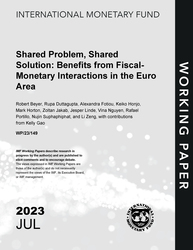
Shared Problem, Shared Solution: Benefits from Fiscal-Monetary Interactions in the Euro Area
Shared Problem, Shared Solution: Benefits from Fiscal-Monetary Interactions in the Euro Area
READ MORE...
Volume/Issue:
Volume 2023
Issue 149
Publication date: July 2023
ISBN: 9798400249051
$20.00
Add to Cart by clicking price of the language and format you'd like to purchase
Available Languages and Formats
| English |
Prices in red indicate formats that are not yet available but are forthcoming.
Topics covered in this book
This title contains information about the following subjects.
Click on a subject if you would like to see other titles with the same subjects.
Inflation , Economics- Macroeconomics , Public Finance , Economics / General , Policy mix , monetary policy , fiscal policy , policy coordination , synchronized fiscal policy , inflation reduction , monetary policy interaction , fiscal policy in the euro area , Annex I , Policy synchronization , Fiscal consolidation , Inflation , Fiscal stance , Global
Summary
This paper employs two established macroeconomic models to show that fiscal policy in the euro area can help monetary policy in reducing inflation. Specifically, a fiscal consolidation of 1 percent of GDP for two years and 0.5 percent in the third year across the euro area would ease the policy interest rate by 30-50 basis points relative to the baseline scenario, while lowering inflation. It would also put the public debt-to-GDP ratio on a downward path, with the output costs reversing after the second year. Additionally, a stronger fiscal contribution to the policy mix could mitigate financial fragmentation risks. In the current context of elevated inflation in all euro area economies, the findings suggest two key takeaways: first, synchronized fiscal and monetary policies offer gains even when monetary policy is unconstrained and, second, sharing the burden of lowering inflation through fiscal consolidation among euro area members is beneficial for union-wide inflation reduction, improving debt sustainability and inducing a lower policy rate path.
Copyright © 2010 - 2025
Powered by:
AIDC



